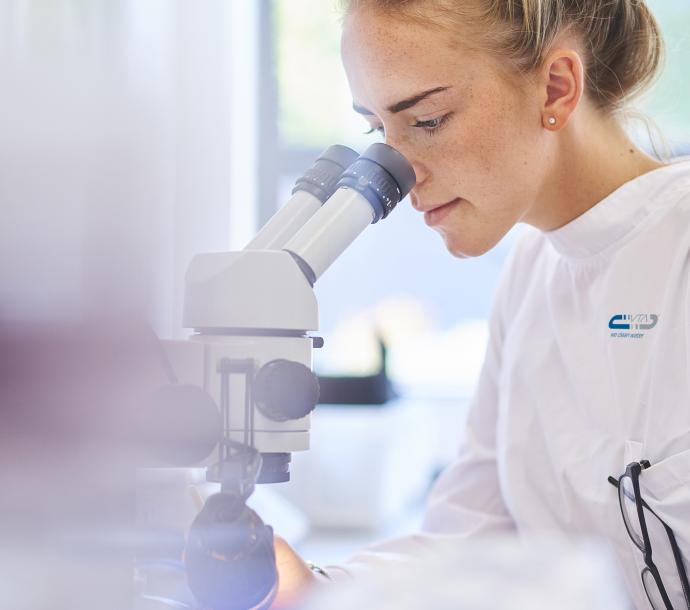
comprehensive process engineering advice
A made-to-measure solution for every problem. Integrated optimisation of treatment plant operation is a job for our specialists.


Our VTA process engineers, biologists and chemists analyse all the processes that take place during wastewater and sludge treatment. Based on their findings, we offer:
comprehensive process engineering advice
individual solutions for each plant
accurate diagnoses and reports to accompany tests

Regular microscopic examinations of activated sludge allow additional monitoring of ecosystem functionality at a wastewater treatment plant.
Number and composition of microorganisms indicate the respective operating condition, malfunctions and certain wastewater properties.
Toxic effects can often be detected even days after an incident using this method.
The experienced team of VTA biologists provides accurate diagnoses of special problems, reports to accompany tests or detailed expert opinions.
Microscopic analysis is a VTA service and offers the possibility of analysing activated sludge or scum samples from wastewater treatment plants in order to make a statement regarding the operating status.
This involves an examination of floc composition, number and diversity of microorganisms, filamentous bacteria and other components (such as emulsified fat droplets). The following statements can be made about the treatment plant based on the findings:
• Load and impact loads
• Nutrient ratio
• Oxygen supply
• Malfunctions
• Sludge age
• Fat content
An analysis report is then produced. This report can be used to indicate operating states or problems and suggest customer-specific solutions based on VTA system products.
Send us around 50 ml of activated sludge or scum along with your full contact details:
VTA Austria GmbH
Umweltpark 1
4681 Rottenbach, Austria
or contact your VTA Technical Field Service.
We look forward to hearing from you.
Fluorescence analysis provides an insight into the ammonium and nitrite oxidising bacteria in a wastewater treatment plant.
These two groups of bacteria are important for a smooth nitrification process. Nitrification plays an important role in the nitrogen cycle of organisms. This process serves as an energy supplier for the growth of bacteria. In the event of insufficient nitrification, ammonium that has not been oxidised may be processed into ammonia that has a toxic effect on biocoenosis and the environment.
Gene-specific sensors are used to stain ammonium, and nitrite oxidisers that can then be detected in the activated sludge.
With the aid of this specific analysis, living bacteria can be detected both quantitatively and qualitatively, and bacterial activity can be assessed.
An analysis report is then produced. Statements can be made about nitrification stability based on this report.
Send us around 5 ml of fresh activated sludge or scum diluted 1:1 with 96% ethanol
along with your full contact details to
VTA Austria GmbH
Umweltpark 1
4681 Rottenbach, Austria
or contact your VTA Technical Field Service.
We look forward to hearing from you
Special VTA products inhibit the activity of the enzyme lipase, which filamentous microorganisms need in order to break down lipophilic substances in wastewater, i.e. for their functioning metabolism. In doing so, these VTA system products inhibit the growth of filamentous bacteria and are therefore ideally suited for combating bulking sludge and scum.
The effectiveness of the individual products depends on the respective general conditions. Measuring lipase activity can determine which special product from the broad VTA range is most effective in inhibiting the growth of filamentous bacteria in the specific application and will therefore lead to success in the fastest and most reliable manner.
Measuring lipase activity using ELF (enzyme-labelled fluorescence) technology is offered exclusively by VTA.
VTA offers a range of services to analyse the initial situation of your system and works with you to develop individual solutions. Based on the analysed data, the technical expert creates an individual solution concept with customised VTA processes for your company.
Do you need more information?
Contact our experts and together we will find the right solution:
Tailored to your requirements, we will find the perfect solution for every challenge.
Get to know all VTA services now.
